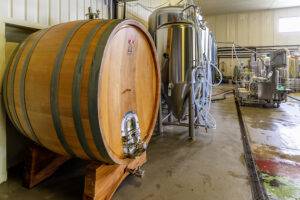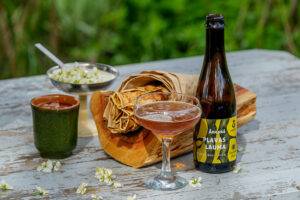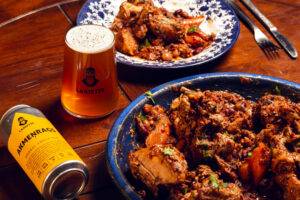EAT WITH BEER. MIĶEĻI
Miķeļi jeb apjumības ir gada auglīgās daļas aizvadīšanas svētki. Labībai jābūt nopļautai, bet kartupeļiem un citām saknēm jātup pagrabā. Apjumībās
BEER AND WOOD. PART 2
Mucā audzis, caur spundi barots. Turpinot tēmu par alus attiecībām ar koka traukiem, kā nākamā jāizceļ koka mucas spēja ļaut
EAT WITH BEER. SUMMER SOLSTICE
Ir pienācis laiks atgriezties pie saknēm. Jāņu svinēšana nav statiska sēdēšana un ēšana. Tā ir kustība. Tieši tāpēc šoreiz aizmirsīsim
EAT WITH BEER. ŪSIŅŠ DAY
Laiks ziedot auglības dievam Ūsiņam! Lai atvērtu auglības vārtus, mūsu senči ziedoja olas, sīpolu mizas, spalvas, kaulus, naudas gabalus un
EAT WITH BEER. Spring Solstice
Kas tik te nav! Te nav padomi, kā krāsot olas. Te nav padomi, ko darīt ar vārītām olām pēc svētkiem.
EAT WITH BEER. METENIS
Gaisā jaušams pavasaris. Dienas kļūst garākas. Un saule atkal kāpjas augstāk. Ir pienācis laiks svinēt Meteni, doties ciemos un maskoties.
Ēd ar alu. Ziemas saulgrieži
Mūsu senči ziemas saulgriežos svinēja auglību. Tā bija zīme, ka saule atgriezīsies un tumsa palēnām atkāpsies. Ziemas periodā, kad darbi
Eat with beer. St.Martins feast in three meals with beer.
Kāpēc Labietis ēd? Domājot par to, kur mēs atrodamies pasaules alus kartē, redzam, ka esam apskaužami ērtā pozīcijā. Proti, mūsu
What is PAGAN BREWS
Šis sauklis nu jau gadu rotā gan pudeles, gan dažādus suvenīrus. Īsumā – PAGAN BREWS visprecīzāk raksturo to, ko mēs,
Mixed fermentation
(Līdz 10 minūšu lasāmviela) Aldara arods ir viens no tiem gadījumiem, kad nosaukums īsti neatbilst patiesībai. Būsim godīgi – aldaris
Alus un koks. 1. daļa
Ar sveicieniem no Asteriksa Koka trauku izmantošana dažādās alus darīšanas stadijās nav nekāds pēdējo gadu jaunievedums. Pirmās ziņas par koka
How to brew beer at home?
Katrs ir aizdomājies par to cik forši būtu uzbrūvēt savu alu. Taču daudziem tas šķitis nesasniedzams mērķis, jo noteikti vajag
Autumn Beer - The British Ale Tradition
Daudziem alus saistās vien ar vasaru vai hokeju, taču būtībā alus pasaules plašums ļauj baudīt šo dzērienu visu cauru gadu,
Ne viss ir IPA
Lai gan arodalus (amatalus, kraftiņš, amatnieku alus, garšīgs alus) Latvijā dzīvojas vismaz 5 gadus (neskaitot vēl ilgāku laiku specializētos veikalos
Berliner Weisse vēsture, jeb kā viltnieks Kords Broians nospēra kāda flāma recepti
Nav zināms precīzi, kur un kad uzvārīja pirmo Berliner Weisse (tie, kuri zina, noklusē vai arī ir miruši), taču klīst
ALE or Lager? | A general introduction of types of beer
“Mums ir tikai eili.” “Bāc! Bet es gribu alu!” Turpinot tēmu par svešvārdiem, īsi un konkrēti nodalīsim, kas ir eils
Kas ir amatalus, jeb kā definēt Craft beer
“Kādreiz bija vienkārši. Tu pasaki “alus” un tev ielej alu – viss, nekādas pratināšanas! A tagad?” – Garšas jautājumu nogurdināts
Braggot, Honey Beer and Mead
Īsa ekskursija medus raudzēšanas vēsturē un etimoloģijā Latvijas teritorijā, kuras mērķis ir aizsākt diskusiju par konsekventu terminoloģiju mūsdienu latviešu valodā
Leģendām apvītais Pokaiņu mežs
Jau ilgu laiku krodzinieki mēļo leģendas par miežu vīnu, kas smēlies spēku konjakā mucā. Priežu pumpuru smeķis apvienojas ar ozolkoku,
Grieķu alus lāsts
KĀ ASPRĀTIS AISHILS NOGRŪDA ALU NO OLIMPA. Raudzēto dzērienu vēsture līdz salīdzinoši nesenam laikam vienmēr bijusi cieši saistīta ar reliģiju,























